Physical Address
304 North Cardinal St.
Dorchester Center, MA 02124
Liver biopsies are often obtained to evaluate abnormalities of liver function tests in patients with known or suspected systemic disease and in the investigation of pyrexia of unknown origin. In the latter, liver biopsy provides diagnostic information in approximately 15%–30% of cases. The hepatic changes associated with systemic diseases vary from obvious granulomas or steatosis (discussed in Ch. 7 ) to more subtle findings, such as an increase in liver-cell mitoses. The pathologist will want to know, whenever possible, whether or not the biopsy changes are specific for a systemic disease. For example, patients with Turner syndrome (karyotype 45,XO) often have abnormal liver tests (elevated aminotransferases and/or alkaline phosphatase) and a spectrum of lesions ranging from nodular regenerative hyperplasia, multiple focal nodular hyperplasia, and cirrhosis to fatty liver disease, periductal fibrosis, or inflammatory hepatocellular adenoma, but these lesions are seen in many other clinical settings as well. In contrast, when granulomas are present, the differential diagnosis is more limited and their aetiology usually has important therapeutic implications. Liver biopsy in patients with acquired immune deficiency syndrome (AIDS) may demonstrate suspected hepatotoxicity due to antiretroviral drugs or hepatic involvement by a micro-organism already identified elsewhere in the patient, or may disclose a new diagnosis such as lymphoma. Liver biopsy also provides tissue for culture and special stains. This chapter examines the pathology of hepatic granulomas, hepatic changes in a variety of infectious diseases and liver involvement in gastrointestinal and haemopoietic diseases and the porphyrias.
In the unusual situation where liver dysfunction is found in pregnancy, the histopathologist may be called upon to differentiate intercurrent conditions such as viral hepatitis from several varieties of liver disease unique to pregnancy. This differential diagnosis is discussed later on in this chapter.
There are many causes of hepatic granulomas, including local irritants, infections, infestations and hypersensitivity to drugs. The constituents of these lesions, depending on the aetiology and inflammatory cytokines produced, include large epithelioid cells, multinucleated giant cells, varied numbers of mononuclear cells and eosinophils. Hepatic granulomas can be further morphologically classified as caseating (necrotising) , non-caseating , lipogranulomas ( Ch. 7 ) and fibrin-ring granulomas . The causes vary in frequency from one country to another. Although the aetiology may be determined from the histological features, from special stains for micro-organisms, from culture of part of the biopsy specimen or polymerase chain reaction of the paraffin-embedded specimen or from clinical and serological data, the cause of hepatic granulomas may remain unknown in some 10% to 36% of cases.
From a practical point of view, biopsies containing granulomas fall into one of four groups:
The cause of the granuloma is seen under the microscope. Examples are the granulomas around schistosome ova, and the mineral-oil lipogranulomas found in portal tracts or near terminal hepatic venules.
The cause is not seen, but other histological features and clinical circumstances make the diagnosis clear. For example, granulomas near damaged bile ducts in a patient with clinically and immunologically typical primary biliary cholangitis are almost certainly due to this disease.
The cause is uncertain, but appearances favour one particular line of further investigation rather than another. For instance, sarcoidosis should be suspected when clusters of large granulomas with prominent epithelioid cells, large multinucleated giant cells and dense fibrosis are found in portal tracts.
The cause of the granulomas cannot be determined from the histological appearances. This is unfortunately common, and the help that the pathologist can then give to the clinician is limited.
These four circumstances can be summarised as see the cause , know the cause , suspect the cause and don’t know the cause . Some of the histological guidelines for evaluating granulomas are summarised in Table 15.1 .
| Aetiology | Favoured site(s) | Special features |
|---|---|---|
| Sarcoidosis | Portal/periportal | Clustering Hyalinisation Inclusions in giant cells May destroy bile ducts |
| Tuberculosis | None | Necrosis |
| PBC | Portal | Near damaged bile duct Lobular granulomas uncommon |
| Drug | None | Eosinophils Other lesions often present (hepatitis, fat, cholestasis) |
| Mineral oil | Portal, perivenous | Oil vacuoles |
| Q fever, CMV, allopurinol, etc. | None | Fibrin-ring granuloma |
| CGDC | None | Brown pigment in macrophages May be necrotising |
| Cat-scratch disease, tularaemia, Yersinia | None | Purulent centre |
Granulomas are found in up to 10% of liver biopsies, although recent studies suggest considerably lower percentages on the order of 2% to 5%. They may be sparse, and suspicion of granulomatous disease is an indication for examining step sections from different levels of a paraffin block, if no lesions are seen initially. Because identifiable granulomas are generally more than 50 μm in diameter, serial sections 5 μm thick are unnecessary unless a single granuloma is to be further investigated.
Granulomas are commonly found in the liver in sarcoidosis and may even recur following liver transplantation. The liver is usually one of several organs involved, but occasionally extrahepatic lesions are difficult to demonstrate and chest X-ray may be normal. Liver biopsy is helpful for diagnosis, especially in patients with fever and arthralgia. The lesions may be found both in portal tracts and in lobules, and consist of well-defined, rounded granulomas with variable infiltration by inflammatory cells, including plasma cells and eosinophils ( Fig. 15.1 ). The granulomas contain reticulin fibres ( Fig. 15.2 ). Multinucleated giant cells may contain inclusions of different types. Central necrosis may infrequently be present but is never as extensive as in tuberculosis. The granulomas often cluster in portal and periportal regions ( Fig. 15.2 ), and older lesions show dense hyalinised collagen. The fibrosis may extend to interfere with normal acinar structure, and in more severe cases may progress to cirrhosis. A surprising degree of reactive portal and lobular inflammation may occasionally be seen in association with sarcoid granulomas, raising the question of concomitant hepatitis. The lobular component consists predominantly of hyperplastic Kupffer cells; acidophil bodies are rare. The portal tracts show considerable variability in the amount of lymphocytic inflammation, and the most active portal inflammation is usually near granulomas. Serological tests for viral hepatitis should be obtained if there is serious diagnostic concern. In those few patients with sarcoidosis who develop portal hypertension, it may be related to portal and periportal fibrosis or to broad areas of replacement fibrosis, nodular regenerative hyperplasia or cirrhosis. Another rare complication of sarcoidosis is a primary biliary cholangitis-like lesion, with destruction of bile ducts and a clinical picture of chronic cholestasis. Portal features suggesting biliary obstruction may also be present. It should be noted that a diagnosis of sarcoidosis cannot be proved by histological examination of the liver alone, because very similar lesions are found in other granulomatous diseases.
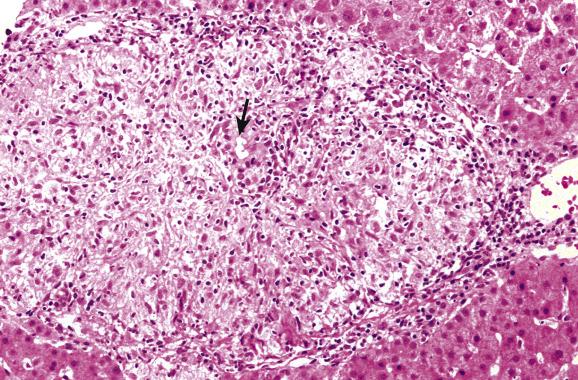
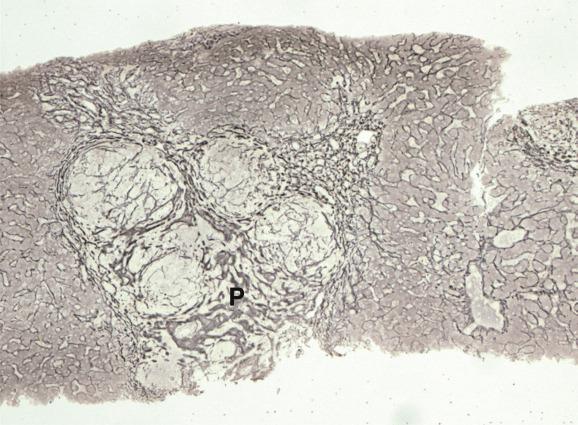
In chronic granulomatous disease of childhood, defective neutrophil leukocyte function leads to the development of infective granulomas of different sizes, containing homogeneous eosinophilic material, necrotic debris or pus. Portal tracts are inflamed, and there may be fibrosis. A brown pigment of ceroid type accumulates in portal macrophages and to a lesser extent in Kupffer cells. Abscesses and bile-duct fibroinflammatory lesions resembling primary sclerosing cholangitis are also seen. The development of non-cirrhotic portal hypertension related to nodular regenerative hyperplasia and obliterative fibrosis of terminal venules and/or portal veins contributes to mortality. Common variable immunodeficiency may be associated with portal and/or lobular epithelioid granulomas. Nodular regenerative hyperplasia (NRH) with elevated serum alkaline phosphatase levels appear to be the common hepatic findings in CVID. NRH or NRH-like lesions may recur if the patient undergoes liver transplantation. Nodular regenerative hyperplasia appears to be the most common hepatic lesion in CVID and is associated with elevated serum alkaline phosphatase, mild portal lymphocytic infiltrates with mild fibrosis and, rarely, primary biliary cholangitis or autoimmune hepatitis.
A small number of patients with chronic hepatitis C may show non-caseating granulomas in the liver, either portal or lobular in location, sometimes recurring after liver transplantation. In one series, nearly 10% of granulomas were ascribed to this infection. Their pathogenesis is unknown. In some instances, other causes such as schistosomiasis may become apparent during a thorough evaluation. Necrotising granulomas at the edges of abscesses due to the Gram-negative bacillus Achromobacter xylosoxidans have been reported after cholecystectomy, with multilobulated ‘coral-like’ masses on computed tomography scan.
Drugs and toxins should be considered in the evaluation of hepatic granulomas ( Ch. 8 ), particularly if eosinophils are prominent. A diverse array of particulate materials may cause granulomas, including aluminium, feldspar and silicone. Biopsies with granulomas should therefore be examined under polarised light for evidence of particulate material. Dense reactive fibrosis may develop in the form of sclerohyaline nodules in individuals exposed to silica, chromium, cobalt or magnesium, either in the workplace or by intravenous drug abuse.
The fibrin-ring granuloma is a distinctive though non-specific form described in Q fever, Hodgkin’s disease, allopurinol hypersensitivity, immune checkpoint inhibitor toxicity, cytomegalovirus (CMV) and Epstein–Barr virus infections, leishmaniasis, toxoplasmosis, hepatitis A, giant-cell arteritis and systemic lupus erythematosus (SLE). This granuloma is composed of a fat vacuole surrounded by a ring of fibrin, epithelioid cells, giant cells and neutrophils ( Fig. 15.3 ). Serial sections may be needed to demonstrate the typical fibrin-ring or ‘doughnut’ lesion.
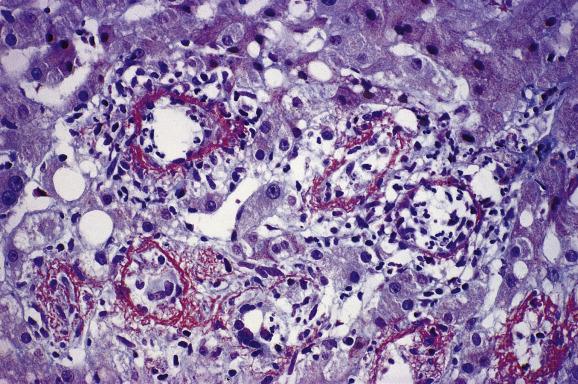
Simon and Wolff described a syndrome characterised by fever, constitutional symptoms and hepatic granulomas, which does not respond to antituberculous drugs but improves on corticosteroid therapy or sometimes with methotrexate. In some patients the syndrome resolves spontaneously without treatment. The cause has not been established.
The pathological changes in the liver resulting from virus infections other than hepatitis viruses have been reviewed by Lucas. The viral haemorrhagic fevers, such as mosquito-borne flavivirus infection ( dengue fever ) and rodent-borne hantavirus infections, are characterised by mid-zonal or more extensive hepatic necrosis. In yellow fever , acidophil bodies are typically abundant; they were first described in this disease by Councilman over 100 years ago.
Several viruses not normally associated with liver disease can occasionally cause liver damage. Examples include herpes simplex virus infection leading to irregular and randomly distributed areas of coagulative necrosis ( Fig. 15.4 ) and adenovirus infection. In both infections, virus particles or antigens can be identified in hepatocytes. Paramyxovirus-like particles were described in adults with associated syncytial giant-cell hepatitis. Multinucleated giant hepatocytes in liver biopsies from adults ( postinfantile giant-cell hepatitis ) may also be seen in hepatitis C virus mono-infection or co-infection with human immunodeficiency virus (HIV), human herpesvirus-6A infection, in autoimmune hepatitis and in other liver diseases.
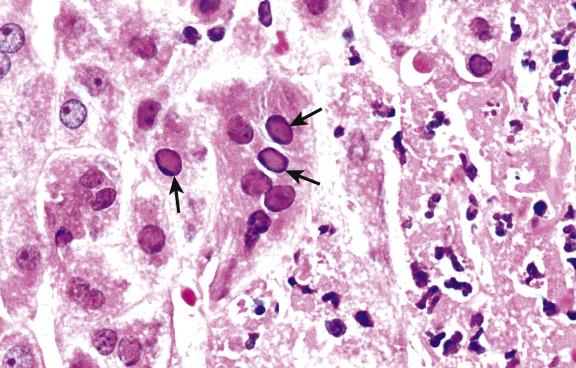
CMV has been implicated in some children with neonatal hepatitis ( Ch. 13 ). Histological features include giant-cell formation as in other forms of neonatal liver damage, inflammation and cholestasis. Bile ducts are damaged and may be destroyed. The CMV genome can be identified by the polymerase chain reaction in many cases.
In later life, CMV infection can present as a mononucleosis-like illness, but also as hepatitis. Asymptomatic infection is common in immunocompromised patients. In these, the histological changes are often mild, but typical CMV inclusions are found in hepatocytes, bile-duct epithelium and endothelial cells ( Fig. 15.5 ). Specific immunocytochemical staining reveals CMV antigens, even in cells without inclusions, but sometimes with an abnormal granular basophilic cytoplasm. Patients with CMV infection may also show aggregation of neutrophils in sinusoids, with or without evidence of CMV in neighbouring cells, an important diagnostic consideration in immunocompromised patients or individuals who have received organ transplants. Larger accumulations of macrophages and lymphocytes can be seen, and epithelioid-cell granulomas have been reported. In immunocompetent patients, there are varying degrees of focal liver-cell and bile-duct damage, portal inflammation, infiltration of sinusoids with lymphoid cells and increased mitoses in hepatocytes. In such patients, it may not be possible to demonstrate CMV inclusions or antigen, a situation possibly analogous to hepatitis B virus infection, where inclusions and antigen may be scanty or absent during the acute attack while characteristic of the carrier state.
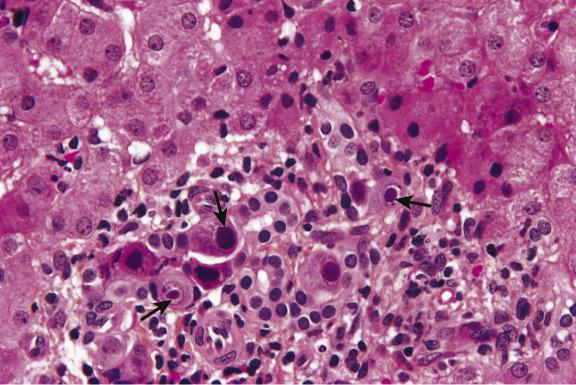
The liver is histologically abnormal in infectious mononucleosis even when there is no clinical jaundice. Dense accumulations of atypical lymphocytes are found in portal tracts and sinusoids ( Fig. 15.6 ). Sinusoidal aggregates must be distinguished from the more heterogeneous collections of cells found in extramedullary haemopoiesis. The infiltration also mimics that of leukaemia. Kupffer cells are enlarged. Epithelioid-cell granulomas are occasionally present. Small foci of hepatocellular necrosis and acidophil bodies may be seen, but the diffuse hepatocellular damage characteristic of viral hepatitis is usually absent and extensive necrosis is rare. Cholestasis is absent or mild.
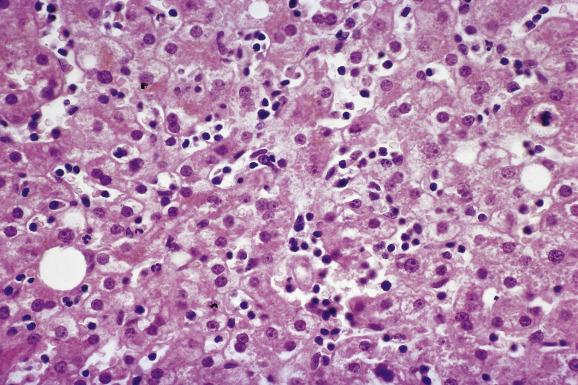
A spectrum of hepatobiliary lesions has been associated with AIDS and HIV-1 infection since the onset of the epidemic ( Table 15.2 ). Liver biopsy continues to play an important diagnostic role in the evaluation of abnormal liver function tests in these patients, particularly in managing the potential hepatotoxicity of highly active antiretroviral therapy (HAART) and the concurrent chronic hepatitis B and/or C, which may be present. Although Kupffer cells and endothelial cells are potential target cells for HIV-1 infection, there are no specific hepatic lesions due to HIV-1, a few cases of alleged ‘HIV-1 hepatitis’ notwithstanding.
| Lesion | Cause(s) or type(s) | |
|---|---|---|
| Granulomas | Mycobacteria, fungi, drugs | |
| Abscesses | Staphylococci, streptococci, listeria | |
| Bacillary peliosis | Bartonella henselae | |
| Biliary tract disease (AIDS cholangiopathy) | CMV, cryptosporidia, microsporidia | |
| Neoplasms | Kaposi’s sarcoma, lymphoma, smooth-muscle tumours | |
| Chronic viral hepatitis | HBV, HCV, HDV | |
| Autoimmune hepatitis | Coexistent or following immune reconstitution | |
| Other viral infections | CMV, herpes simplex virus, Epstein–Barr virus, adenovirus | |
| Vascular lesions | Peliosis hepatis, sinusoidal dilatation | |
| Drug toxicity | Sulpha agents, antiretrovirals | |
| Miscellaneous | Steatosis, haemosiderosis, stellate cell hypertrophy, amyloidosis | |
Despite the reduction in morbidity and mortality due to antiretroviral therapy and prophylactic antibiotics, opportunistic infections and neoplasms such as Kaposi’s sarcoma and lymphoma must still be excluded on liver biopsy. Specimens should routinely be studied with acid-fast and silver stains for detection of high-incidence pathogens such as mycobacteria and fungi. Other methods such as Gram or Warthin–Starry stains can be applied, depending on the clinical and histological indications. A portion of the biopsy should be sent for culture.
Antiretroviral drugs may need to be excluded as the cause of liver dysfunction in HIV-positive individuals, particularly in those with negative hepatitis virus serology. Combination therapy frequently presents the problem of distinguishing among various medications. Some of the newer antiretroviral agents have been associated with elevated serum liver enzymes, but few morphologic data are available. It is helpful to consider the type of hepatic damage reported with the several classes of HAART agents . The nucleoside reverse transcriptase inhibitors cause mitochondrial damage and microvesicular steatosis, while the non-nucleoside reverse transcriptase inhibitors may produce hepatitis and confluent necrosis. The lesions attributed to protease inhibitors are various, including bile-duct damage, hepatocyte necrosis and ballooning, Mallory–Denk body formation, steatohepatitis and perivenular fibrosis. Liver biopsy in some individuals receiving combined antiretroviral therapy shows coarse brown hepatocellular pigment granules resembling the pigment of Dubin–Johnson syndrome, often panlobular in distribution ( Fig. 15.7 ). The specific causative drug has not been identified. As antiretroviral liver injury is often idiosyncratic, the internet and other sources should be consulted for emerging descriptions of new cases.
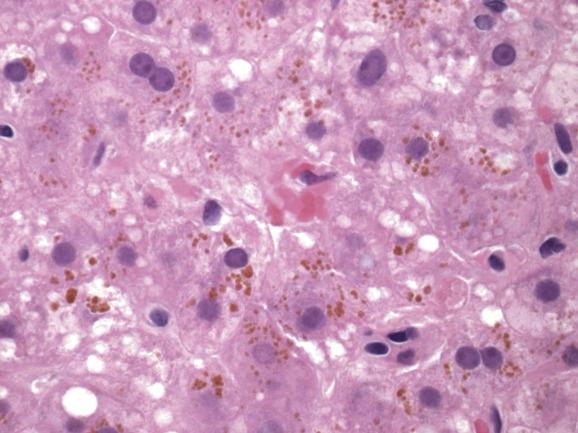
Opportunistic infections and infestations involving the liver and bile ducts in AIDS include Mycobacterium avium–intracellulare and Mycobacterium tuberculosis infections, CMV infection, cryptococcosis, candidiasis, histoplasmosis, leishmaniasis, malaria, cryptosporidiosis and microsporidiosis. Mycobacterial and fungal infections frequently produce granulomas . M. avium–intracellulare results in numerous granulomas and the organisms are readily demonstrated by staining with diastase–periodic acid–Schiff (PAS) or the Ziehl–Neelsen method ( Fig. 15.8 ). Each granuloma consists of foamy histiocytes with few lymphocytes. The histiocytes often show a striated appearance on haematoxylin and eosin (H&E) staining due to the abundant packing of organisms in each cell. M. avium–intracellulare organisms are also well stained with Gomori methenamine silver. For screening of liver biopsies, particularly for M. tuberculosis, which may be present in fewer numbers than M. avium–intracellulare , the auramine–rhodamine fluorescent method gives excellent results. Careful examination of special stains is of particular importance, as some AIDS patients have mycobacterial infection without typical granuloma formation; scant, single mycobacteria may be present within sinusoids or portal tracts. Pneumocystis carinii may disseminate to the liver, producing acellular exudative masses which closely resemble the pulmonary alveolar exudates.
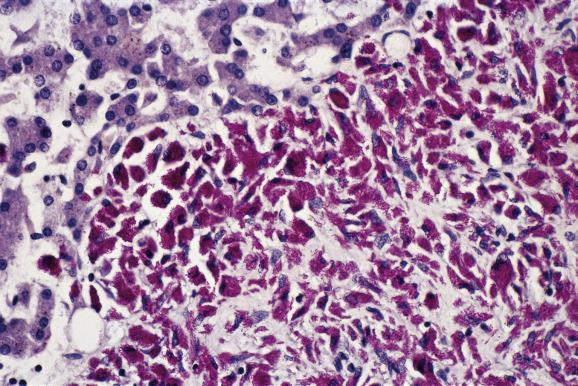
AIDS cholangiopathy resembles sclerosing cholangitis clinically and radiographically and is due to infections of the large bile ducts by several possible pathogens, including CMV, cryptosporidia and microsporidia. Liver biopsy changes are those of large-duct obstruction. Cryptosporidia and microsporidia are best identified in aspirates obtained at endoscopy, duodenal biopsies or postmortem tissue samples of the major bile ducts.
Peliosis hepatis in AIDS has been postulated to be due to endothelial damage by HIV-1 infection. Alternatively, bacillary peliosis hepatis may develop as a consequence of hepatic infection by the Gram-negative bacillus Bartonella henselae. Smudge-like or granular pink-to-purple material associated with a myxoid stroma is seen within dilated vascular spaces ( Fig. 15.9 ), and the Warthin–Starry stain shows clumped bacilli in these areas.
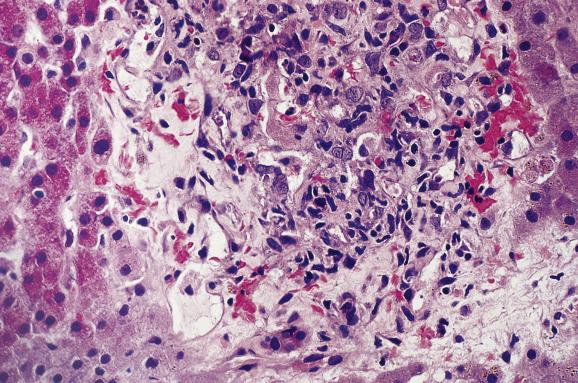
Lymphomas involve the liver as nodular masses or portal tract infiltrates ( see Fig. 7.3 ) and are high-grade large-cell, immunoblastic and Burkitt types.
AIDS patients have many of the same risk factors for infection by hepatitis viruses, and serum markers of prior infection or active viral hepatitis are often present. While the liver biopsy lesions of chronic hepatitis B, C and delta can vary considerably in persons infected with HIV, it is now recognised that HIV infection may exert an adverse effect with accelerated progression of fibrosis. Fulminant hepatitis may occur, and in drug addicts a propensity for more severe chronic hepatitis with progression to cirrhosis has been noted. The long-term outlook for HIV-HCV coinfected individuals is likely to change in the future due to effective anti-retroviral therapy and direct-acting antiviral (DAA) treatment of HCV, unresolved questions of cost and access of DAA notwithstanding. Coexistent autoimmune hepatitis may need exclusion when abnormal serum liver tests are found in the HIV-infected individual and rarely de novo autoimmune hepatitis may develop because of immune reconstitution after antiretroviral therapy has begun.
Steatosis is common and occasionally is periportal (see Fig. 7.4 ). Severe macrovesicular or microvesicular fat is cause for concern because this may reflect toxicity of antiviral medications and can be associated with liver failure. Non-alcoholic steatohepatitis (NASH) and abnormal liver enzymes may be present because of concomitant insulin resistance and features of metabolic syndrome. Siderosis of Kupffer cells is related to transfusion or viraemia-associated erythrophagocytosis. In some cases, non-specific changes consisting of sparse portal or acinar lymphocytic inflammation with scattered apoptotic bodies are seen, with no apparent aetiology.
Other lesions reported include nodular regenerative hyperplasia , amyloidosis and hypertrophied perisinusoidal stellate (Ito) cells containing numerous lipid droplets. In children, giant-cell hepatitis , chronic hepatitis of uncertain cause and primary leiomyosarcoma are described.
In Q fever, due to infection with Coxiella burnetii , liver involvement is common, although only a few patients present clinically with liver disease. Histological changes include focal necrosis, non-specific inflammation and fatty change. The most characteristic lesion is the fibrin-ring granuloma ( see Fig. 15.3 ), a granulomatous lesion is also seen in several other infections and in some patients taking allopurinol. Atypical lesions without annular arrangement or a central clear area (but containing irregular fibrin strands) are also found, as are non-specific granulomas without fibrin. In chronic Q fever, progressive fibrosis and cirrhosis have been reported.
In most patients with brucellosis, liver biopsy shows non-specific reactive changes comprising sinusoidal-cell hypertrophy, portal inflammation and focal necrosis. Non-necrotising granulomas, often small and located within the acini, are more commonly found in the acute phase of the infection.
Liver involvement is uncommon, but most patients with ‘typhoid hepatitis’ are jaundiced. Liver biopsy shows a mild hepatitis with marked hyperplasia of mononuclear phagocytes, and lymphocytoid cells in sinusoids. Characteristic granuloma-like collections of mononuclear cells, the typhoid nodules, are described. Other features include fatty change and portal inflammation.
Become a Clinical Tree membership for Full access and enjoy Unlimited articles
If you are a member. Log in here